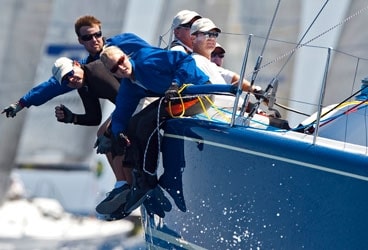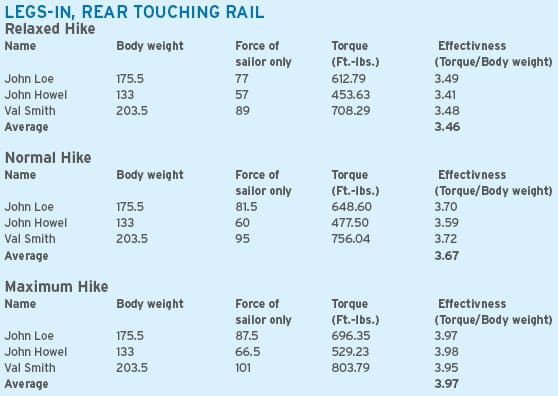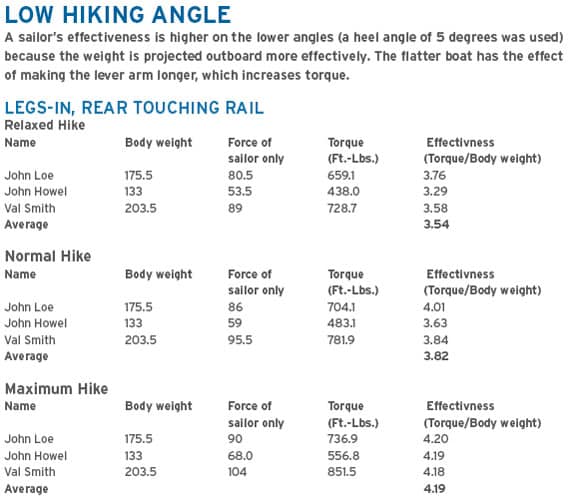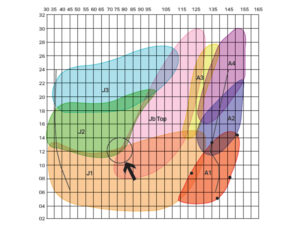
hiking out 368
Most sailors think they hike hard. This is mainly so because they’re experiencing excrutiating pain, or they’re hiking harder than others around them. These sailors often equate pain with effectiveness, and while this is sometimes true, the two are not always linked. Proper hiking technique can allow the same effort to produce increased torque and thus additional righting moment onto a boat. In other words, sometimes the superior hiking technique may actually be more comfortable than a less effective and more painful method.
A similar, non-sailing example would be when the average person lifts weights in their local gym. They typically try as hard as they can, unaware of a proper, more effective technique. Experienced weight lifters, on the other hand, would know how to make the most of their strength in order to lift heavier barbells using the same amount of muscle. Hiking is much the same: most people just try hard, deal with the pain, and don’t bother to consider a more effective method.
An example of a keelboat-a J/22 for example-where one can choose to hike legs-in or legs-out, is one of the most interesting scenarios for examining various hiking styles. Situations where we see both styles used in tandem are very common in both fleet racing and match racing (as demonstrated in the photo above).
After racing in a number of small keelboat events where various hiking styles were used, all within the class rules, the different techniques were interesting to watch. Some seemed excessively physically demanding yet not all that productive. I asked many people about their hiking methods, and not surprisingly, each person was convinced their method was the most effective. To get to the bottom of it, we headed to our “lab” for a little experimentation.
To test the various techniques, we built a hiking bench that modeled the rail of a keelboat. The rail had no lifelines, so as to mimic many small keelboats used in fleet racing and match racing. The test subject used a rope from which to hike off of. This simulated the practice of hiking while holding onto a working sheet, which is permitted by RRS 49.
Seven people of various heights and weights from 130 pounds and 5’3″ all the way up to 6’5″ and 244 pounds were tested. We chose people evenly spaced throughout this weight and size range in order to see if different body types were more effective with different methods. All participants were young, athletic sailors.
The study measured the total torque a sailor exerted on a boat due to different hiking positions. Torque is measured in foot-pounds, so it is the amount of pounds exerted at a right angle to an arm at a certain distance away from a fixed pivot point (fulcrum). The end of the hiking rail was placed on a scale, which measured the vertical component of the force exerted on the bench.
The force measured on the scale is not at a right angle to the lever arm of the hiking bench, so we compensated for this by measuring the length of the arm from the fulcrum, horizontally, to the point where we measured the force. Calculating torque in this way is mathematically equivalent to measuring the force in a right angle to the rail, and therefore, according to our engineer colleauges, is much more accurate.
Because the total torque a person can create depends on their bodyweight, we calculated the effectiveness of their hiking in foot-pounds (exerted on the bench) and divided that figure by their bodyweight (in pounds). This effectiveness ratio could then be compared evenly across all bodyweights and rail angles to determine the relative effectiveness of all hiking techniques.
The experiment tested the legs-outboard style with three different methods of hiking: A relaxed, feet-out hike, likely used in a casual weeknight race; a “normal” hike, which is hiking as hard as would be sustainable for a standard one-hour buoy race, and a maximum-effort hike, which can only be held for 2 minutes, to simulate hiking off the starting line.
For the legs-in hiking technique, the participants used five different styles: we calculated a relaxed, hard, and short-burst maximum, with the caveat that the sailors bottom must be in contact with the rail. This delineation is used in some classes (i.e., the J/22) to limit hiking. Next, we measured a soft and hard hike, with no limit to how far outboard a sailor’s bottom could be (a technique most common in match-racing.)
All of the participants performed the eight different hiking styles at three angles of heel common on keelboats. This measured how the effectiveness of each hike changes over variations in heel angle. Many people overlook the importance of hiking when a boat is almost flat; however, this, we discovered, is when the hiking action is most effective. As heel increases, a smaller percentage of a sailor’s weight is directed perpendicular to the lever arm, which decreases the sailor’s effect on the boat’s righting moment. In other words, it may be more effective to depower the sails to flatten the boat than to have the entire crew exhausting themselves.
Reviewing the data revealed a few interesting conclusions. A sailor hiking legs-out with a normal intensity exerts more torque than any of the legs-in positions. For example, I produced 4.26 pounds of torque in the legs-out, normal position whereas even in the maximum-effort, legs-out unrestricted position I only produced 4.04 pounds of torque. Thus, hiking legs-out is more effective, and it’s more effective than legs in with additional effort. However, hiking legs out is not always the best option. In a race where frequent tacks or other maneuvers occur, it may not be feasible to hike legs-out. Also, if sail trim suffers as a consequence of hiking legs out, then consider another option.
Our findings, explained in the tables at the end of this article, shows how effectiveness was measured and also the ratio of bodyweight to torque produced. This ratio is the key measurement in how effective one’s hiking is. Note how it’s higher when the subject is feet out as compared to feet in, yet how the difference decreases when the heel angle increases. Also, the difference between the relaxed modes and the more aggressive types are quite noticeable. In other words, the skipper who is always yelling, “Hike harder,” isn’t just torturing you.
But next time you’re racing on a boat where different hiking styles are allowed, don’t just hike so it hurts; use the mode that helps keep the boat flat while letting you work the sails and keep your eyes on the racecourse.
John Loe is a sailing coach and Val Smith is an engineer with Viking Systems. “From the Experts” in our October 2009 issue













